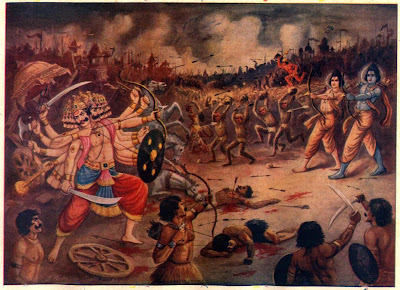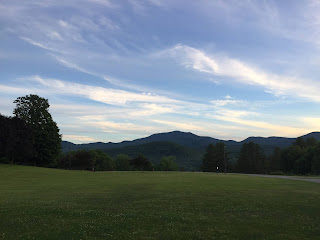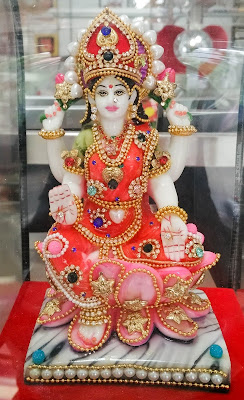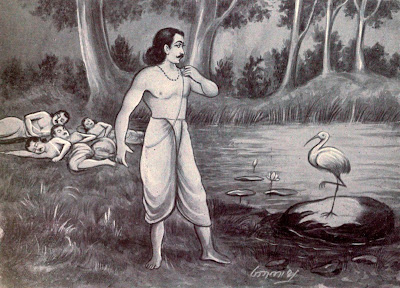Reading Notes: Ramayana Part D
Small But Mighty Characters:
-Garuda: Mighty eagle who helps vanquish the attacks of the serpent soldiers
-Matali: Driver of the chariot Rama fights Ravana in
-Trijata: One of Ravana's women, reassures Sita that Rama only appears dead, and is actually in a faint
Hanuman's Powers
Hanuman is able to cross the sea with a single step after tapping into the Godly powers that he possesses. The Ramayana describes how his father has cursed him so that his powers remain hidden until he finds the inner strength to uncover them in times of need. What other amazing powers does Hanuman possess? It would fun to write a story about him discovering all that he is capable of, and testing out his newfound abilities. Perhaps he could discover them in the form of quests, each one forcing him to unveil a new aspect of his identity so that he may complete the task at hand.
Powerful Women
"Lakshmana... discovered an army of women approaching him with determination."
-Strong women are a hallmark of the Ramayana. They speak their minds and are often one step ahead of their male counterparts. While Sugreeva is drunk and living lavishly, ignoring his duties and his promise to Rama, his wife Tara and her attendants receive Lakshmana and calm him down with the assurance that Sugreeva has sent messengers to gather his armies. (Tara is also the one to warn Vali of Sugreeva's challenge earlier in the Ramayana, and by scorning these words of warning because they came from a woman's tongue leads, he is led to his death at the hands of Sugreeva's ally, Rama.) Sita shows her strength as she resists the aggressive advances of Ravana, protecting her body integrity and purity. Her spirit is so fiery that when she jumps into a pyre at the end of the Ramayana, the God of fire himself burns out.
-The primary responsibility of the female characters, however, is supporting the male characters, which can be detrimental to their individual character development. They take a back seat when it come to the roles of leading and commanding, and are usually only referenced in relation to a male character that they interact with. These women deserve their own epics, and stories as powerful as the fires that burn within them.
When Epics Overlap
One of the final scenes of the battle of Lanka involves Rama cutting off Ravana's heads and arms, which regenerate even as the severed limbs fall lifelessly to the earth. The severed arms are said to have struck Matali and the chariot he drove, causing destruction of their own free will. Ravana's unique physical form reminded me of an evil creature in Greek Mythology known as Medusa, who possesses snakes for hair, and it also reminded me of Fluffy, the three headed dog-beast in Harry Potter. Having extra limbs or autonomous body parts appears as a motif in the world of villainy; they allow an evil creature to appear more frightening and have the power to strike in many directions at once, thus increasing their potential for destruction. Heroes never seem to possess these extra body parts; perhaps they are used only to describe villains because of their grotesque and inhuman nature, marking evil through physical deformity.
~~~
Bibliography
Narayan, R.K. The Ramayana: A Shortened Modern Prose Version of the Indian Epic.
-Garuda: Mighty eagle who helps vanquish the attacks of the serpent soldiers
-Matali: Driver of the chariot Rama fights Ravana in
-Trijata: One of Ravana's women, reassures Sita that Rama only appears dead, and is actually in a faint
Hanuman's Powers
Hanuman is able to cross the sea with a single step after tapping into the Godly powers that he possesses. The Ramayana describes how his father has cursed him so that his powers remain hidden until he finds the inner strength to uncover them in times of need. What other amazing powers does Hanuman possess? It would fun to write a story about him discovering all that he is capable of, and testing out his newfound abilities. Perhaps he could discover them in the form of quests, each one forcing him to unveil a new aspect of his identity so that he may complete the task at hand.
Powerful Women
"Lakshmana... discovered an army of women approaching him with determination."
-Strong women are a hallmark of the Ramayana. They speak their minds and are often one step ahead of their male counterparts. While Sugreeva is drunk and living lavishly, ignoring his duties and his promise to Rama, his wife Tara and her attendants receive Lakshmana and calm him down with the assurance that Sugreeva has sent messengers to gather his armies. (Tara is also the one to warn Vali of Sugreeva's challenge earlier in the Ramayana, and by scorning these words of warning because they came from a woman's tongue leads, he is led to his death at the hands of Sugreeva's ally, Rama.) Sita shows her strength as she resists the aggressive advances of Ravana, protecting her body integrity and purity. Her spirit is so fiery that when she jumps into a pyre at the end of the Ramayana, the God of fire himself burns out.
-The primary responsibility of the female characters, however, is supporting the male characters, which can be detrimental to their individual character development. They take a back seat when it come to the roles of leading and commanding, and are usually only referenced in relation to a male character that they interact with. These women deserve their own epics, and stories as powerful as the fires that burn within them.
When Epics Overlap
One of the final scenes of the battle of Lanka involves Rama cutting off Ravana's heads and arms, which regenerate even as the severed limbs fall lifelessly to the earth. The severed arms are said to have struck Matali and the chariot he drove, causing destruction of their own free will. Ravana's unique physical form reminded me of an evil creature in Greek Mythology known as Medusa, who possesses snakes for hair, and it also reminded me of Fluffy, the three headed dog-beast in Harry Potter. Having extra limbs or autonomous body parts appears as a motif in the world of villainy; they allow an evil creature to appear more frightening and have the power to strike in many directions at once, thus increasing their potential for destruction. Heroes never seem to possess these extra body parts; perhaps they are used only to describe villains because of their grotesque and inhuman nature, marking evil through physical deformity.
The great battle at Lanka. Source: Wikimedia Commons
~~~
Bibliography
Narayan, R.K. The Ramayana: A Shortened Modern Prose Version of the Indian Epic.




Comments
Post a Comment